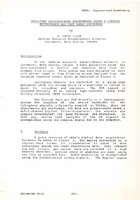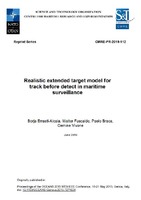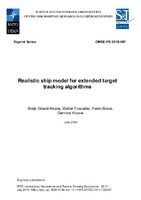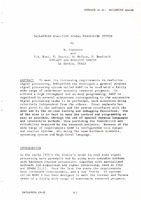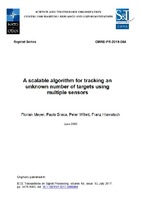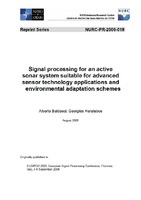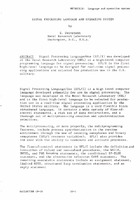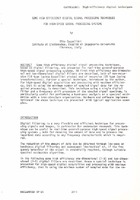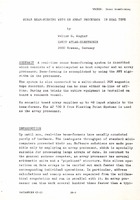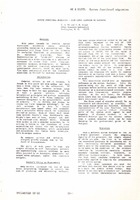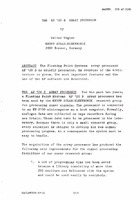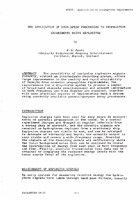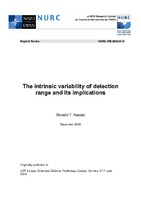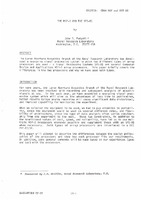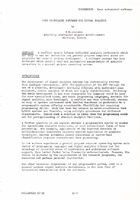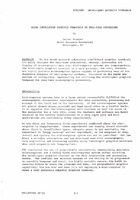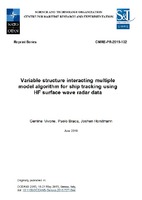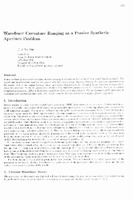Browsing Reprints by Subject "Signal processing"
Now showing items 61-78 of 78
-
Real-time expanded-band beamforming using a complex heterodyner and fast array processor
(NATO. SACLANTCEN, 1979/12)At the Defense Research Establishment Atlantic Dartmouth, Nova Scotia, Canada a data aquisition sytem been engineered to monitor and beamform data from element line arrays. This system has been designed to with either towed ... -
Realistic extended target model for track before detect in maritime surveillance
(CMRE, 2019/06)Traditional target tracking algorithms are generally fed a set of thresholded detections under the hypothesis that no more than one detection is generated by each single target. Improvements in modern radar systems have ... -
Realistic ship model for extended target tracking algorithms
(CMRE, 2019/06)Recent developments in high resolution sensors have encouraged the use of Extended Target Tracking (ETT) algorithms specifically designed to deal with targets that generate more than one detection per frame. At the same ... -
SACLANTCEN real-time signal processing system
(NATO. SACLANTCEN, 1979/12)To meet its increasing requirements in real-time signal processing, SACLANTCEN has developed a general purpose. signal processing system called WARP to be uS.ed with a fairly wide range of underwater acoustic research ... -
A scalable algorithm for tracking an unknown number of targets using multiple sensors
(CMRE, 2019/06)We propose an algorithm for tracking an unknown number of targets based on measurements provided by multiple sensors. Our algorithm achieves low computational complexity and excellent scalability by running belief propagation ... -
Signal processing for an active sonar system suitable for advanced sensor technology applications and environmental adaptation schemes
(NURC, 2006/08)An overview of the basic elements of an active sonar system in conjunction with a description of the signal processing chain utilized at the NATO Undersea Research Centre for detection and localization of undersea targets ... -
Signal-processing language and operating system
(NATO. SACLANTCEN, 1979/12)Signal Processing Language/One (SPL/I) was developed at the Naval Research Laboratory (NRL) as a high-level computer programming language for signal processing. SPL/I is the first high-level language to be designed for ... -
Some high efficiency digital signal processing techniques for high speed signal processing systems
(NATO. SACLANTCEN, 1979/12)Some high efficiency digital signal processing techniques, based on digital filtering are presented for real-time general-purpose, high-speed signal processing systems. At first high efficiency one-dimensional and ... -
Sonar beam-forming with an array processor in real time
(NATO. SACLANTCEN, 1979/12)A real-time sonar beam-forming system is described which consists of a minicomputer as host computer and an array processor. Beam-forming is accomplished by using the FFT algorithm in the processor. The system is also ... -
System functional migration: high-level language to hardware
(NATO. SACLANTCEN, 1979/12)This paper intends to examine system functional allocation among available processing resources in a systematic way. The discussion will focus first on the criteria for assigning functions to processors, that is, horizontal ... -
The AP-120B array processor
(NATO. SACLANTCEN, 1979/12)The Floating Point Systems array processor AP 120 B is briefly presented. An overview of the architecture is given. The most important features and the use of the AP software are described -
The application of high-speed processors to propagation experiments using explosives
(NATO. SACLANTCEN, 1979/12)The possibility of analysing explosive signals directly, without an intermediate recording system, offers large improvement~ in the quality and rapid availability of results from acoustic propagation experiments. The ... -
The intrinsic variability of detection range and its implications
(NURC, 2009/12)The range of first detection of an approaching target is among the most important parameters defining sensors and defensive surveillance systems. A demonstration of capability typically consists of staged approaches of a ... -
The MPS-3 and the SPS-81
(NATO. SACLANTCEN, 1979/12)The Larqe Aperture Acoustics Branch of the Naval Research Laboratory has developed a sea-qoinq signal processinq system in which two different types of array processors are used - a Signal Processing Systems SPS-81 and ... -
User-orientated software for signal analysis
(NATO. SACLANTCEN, 1979/12)A conflict exists between dedicated analysis instruments which are easy to use but inflexible and general purpose computers which are adaptable but require program development. A software package has been. developed which ... -
Using intelligent graphics terminals in real-time processing
(NATO. SACLANTCEN, 1979/12)At the Naval Research Laboratory intelligent graphics terminals are being utilized for real-time acquisition, storage, processing and display of oceanographic data when mini-computer systems are inappropriate. The intelligent ... -
Variable structure interacting multiple model algorithm for ship tracking using HF surface wave radar data
(CMRE, 2019/06)These last decades spawned a great interest towards low-power High-Frequency (HF) Surface-Wave (SW) radars for ocean remote sensing. By virtue of their over-the-horizon coverage capability and continuous time mode of ... -
Wavefront curvature ranging as a passive synthetic aperture problem
(NATO. SACLANTCEN, 1997)A new method of wavefront curvature passive ranging is introduced that is based on a model-based approach. The signal and measurement systems are placed into state-space form, thereby allowing the unknown parameters of the ...
